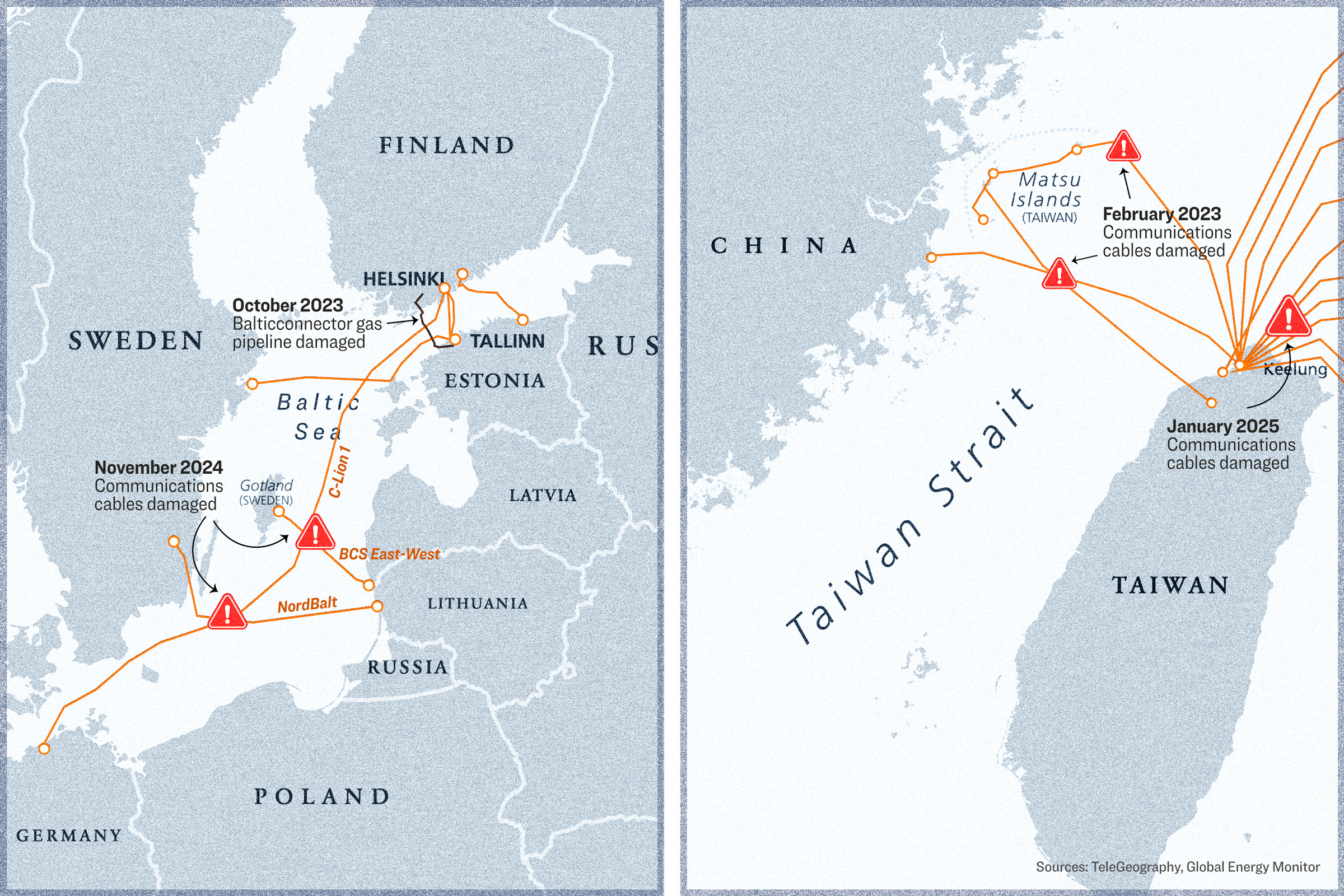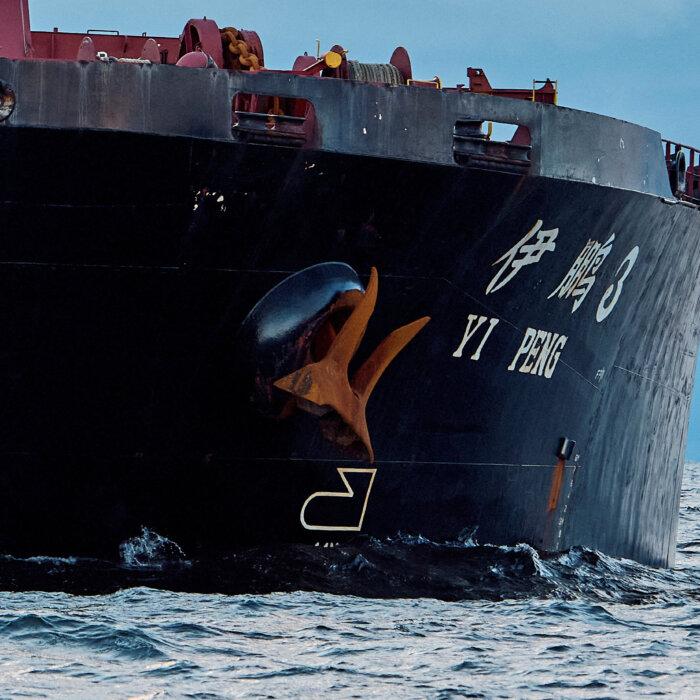Undersea cables crisscross the world’s waterways, connecting nations with power, natural gas, and ready internet access.
Hundreds of thousands of miles of these cables, sometimes no wider than a garden hose, traverse the globe, carrying roughly 97 percent of the world’s communications.
Their near-universal presence and their importance in maintaining modern civilization, however, have made them a rich target for international acts of aggression that fall short of war, sometimes referred to as “gray zone” conflict.
In the past year and a half alone, there have been no fewer than 13 gray zone incidents in which submarine cables have been cut in what are believed to be acts of sabotage. The bulk of these alleged acts of disruption have been attributed to vessels from either China or Russia and have occurred in the Baltic Sea and the Taiwan Strait.
In both regions, the powers believed to be responsible stand to gain in their ongoing conflicts, with communist China seeking to assert a historical claim to the territory of Taiwan and Russia seeking to undermine the stability of the NATO alliance.
As such, the growing threat has raised fears that smaller nations such as Taiwan could suddenly be cut off from communication with much of the world or lose access to key energy supplies in the event of a conflict or other crisis.
Unlike Russia, which has exclusively conducted such operations in the Baltic, vessels linked to China are alleged to have sabotaged cables in both regions, apparently as part of a wider strategy to undermine the existing international order and to increase the influence of its ruling Chinese Communist Party.
Here’s a look at four of the major cable-cutting incidents that have been linked to China in the past two years.

January 2025: Taiwan Telecom Cable
The Shunxin 39, a cargo ship owned by a Hong Kong-based company but registered in Cameroon and Tanzania, is believed to have damaged one of the 14 cables linking Taiwan to mainland Asia.Taiwan’s coast guard sent a ship to investigate after receiving a report of connection problems from local telecommunications provider Chunghwa Telecom, saying that an undersea cable had been damaged off the island’s northern coast.
The coast guard exchanged radio communications with the ship but was unable to board because of bad weather. Authorities subsequently ordered the cargo vessel to head to Taiwan’s Keelung port for investigation, but the ship continued toward China.
Guo Wenjie, head of the Jie Yang Trading company, which owns the ship, has denied involvement in the incident but has thus far declined to say why the ship was loitering in the waters north of Taiwan for at least a month before the incident occurred.
Complicating the matter is the fact that the ship appeared to carry two automatic identification systems (AIS), which are maritime tracking devices that transmit and receive information about a vessel’s identity, position, course, and speed.
One of the systems identified the ship as the China-flagged Shunxin 39, and the other as the Tanzania-flagged Xing Shun 39.
Complicating the matter, the vessel turned off its AIS on the day of the incident, when GPS data obtained by Taiwanese authorities showed the ship crisscrossing over multiple subsea cables, possibly while dragging its anchor to cut the cables.
Several days later, the Mongolia-flagged but Chinese-named Bao Shun cargo ship began moving in a zigzag pattern through the waters near Taiwan before being driven off by the coast guard.
Taiwan’s digital ministry said the sea cable cut on Jan. 3 did not limit service because an available backup line was activated.

November 2024: Communications in Baltic
The Yi Peng 3, a Chinese-owned and operated cargo ship, is alleged to have cut two vital communications cables in the Baltic Sea: one connecting Finland and Germany and the other connecting Lithuania and Sweden.After leaving the Russian port of Ust-Luga on Nov. 15, 2024, for an unknown destination, the Yi Peng 3 traveled to the area above the first cable before switching off its AIS and allegedly dragging its anchor in a zigzag pattern for more than 100 miles.
German Federal Minister of Defense Boris Pistorius described the incident as sabotage. In the first such enforcement action since 1959, the vessel was temporarily detained at sea.
For a time, the Danish navy guarded the vessel while an international team negotiated with China to board it as part of an investigation into potential sabotage.
Chinese authorities eventually invited representatives from Sweden, Germany, Finland, and Denmark to board the vessel as observers during a Chinese-led investigation.
Swedish prosecutors leading a European investigation were not permitted to board, however, and China refused requests to bring the vessel into Swedish waters, where the nation would have the legal right to detain the ship for the duration of an investigation.
On Dec. 17, 2024, a Russian naval tug passed the vessel at low speed with its AIS turned off. Four days later, the Yi Peng 3 lifted anchor of its own volition and departed the region for the Indo–Pacific.
The vessel’s actions continue to be investigated by European powers as an act of sabotage.

October 2023: Gas Pipeline, Fiber Optics
The Chinese-owned, Hong Kong-flagged container ship Newnew Polar Bear is believed to have coordinated with a Russian container ship in the sabotage of a natural gas pipeline and two nearby fiber optic cables connecting Finland and Estonia.
An Estonian naval official said at the time that the Balticconnector gas pipeline’s concrete cover had been broken off and that the pipeline was badly damaged and out of position. A key possibility remaining under investigation is that the Newnew Polar Bear dragged its anchor across the cables.
Estonia requested that China’s ruling communist authorities allow it to seek evidence from the vessel and its crew, but it was rebuffed.
Instead, nearly a year later, China claimed to have conducted its own investigation, saying that the vessel had accidentally caused the damage during a large storm. Estonia and Finland continue to conduct a criminal inquiry into the matter.
The pipeline was repaired and restarted operation in April 2024.

February 2023: Communications in Taiwan
Two undersea cables connecting Taiwan’s Matsu islands with its main island were cut, disconnecting 14,000 residents from the internet and crippling associated services such as text messaging.Taiwanese authorities said at the time that, based on AIS data, three Chinese vessels appeared to be responsible for the damage.
The first was a Chinese fishing vessel that Taiwan’s coast guard chased out of the area on Feb. 2, 2023. The second and third were unknown Chinese cargo ships that appeared to loiter in the area on Feb. 8.
It ultimately took 50 days for the cables to be repaired and services to be restored to Matsu.
Since then, investigations have revealed patent applications that suggest researchers in China have been developing technologies to sabotage undersea cables for at least a decade and a half.
That device was intended to be dragged behind a tug and hooked to undersea cables in order to cut them, according to the patent application, and contained a sensor to detect residual traces of copper so that the crew using it would know when a cable had been successfully severed.
















